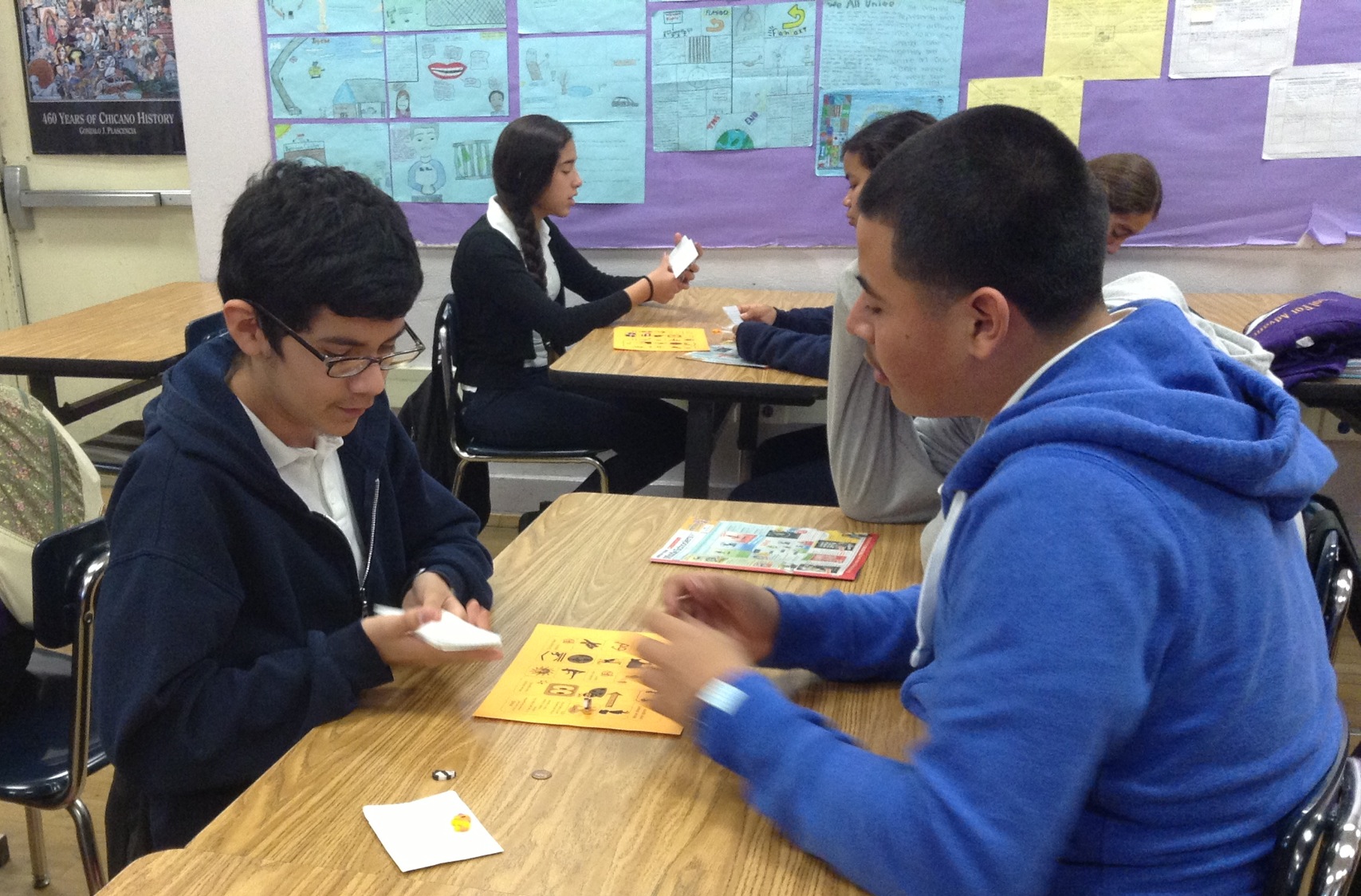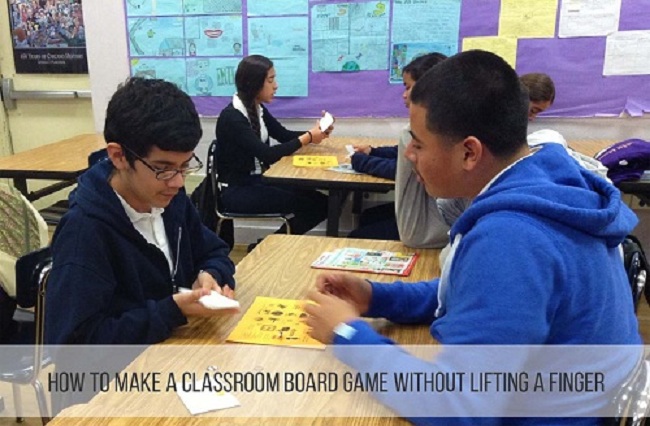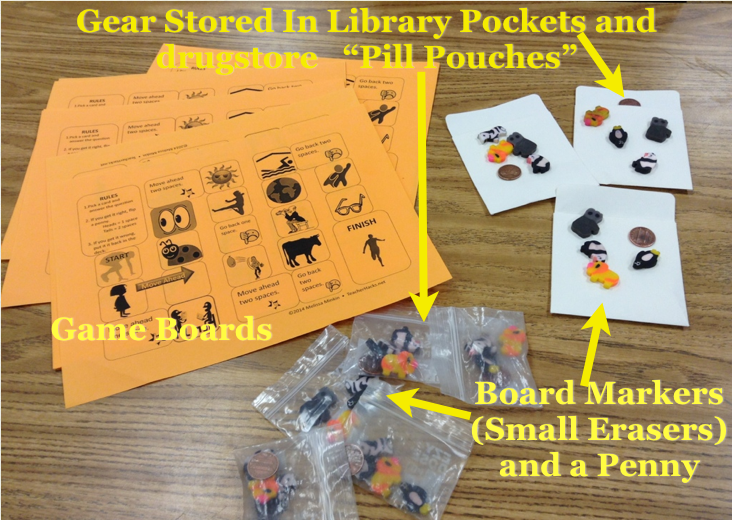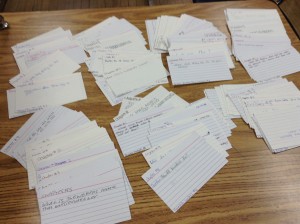I love playing games at school. I create lots of classroom board games to help students learn academic vocabulary, review concepts and discuss ideas.
Sounds like a lot of work, doesn’t it? It doesn’t have to be when you have the kids do the heavy lifting – mentally.
Last week’s lesson was a great example of what Doug Fisher, PhD calls “shifting the cognitive burden” from teachers to students.
We are reading the novel Copper Sun by Sharon Draper. I wanted to make sure my students were engaged in the first few chapters so that their interest would carry them through the rest of the novel. So I had them create a game, which we played about 30 minutes later.
How did I do it so fast? By shifting the cognitive burden. In other words, creating the game questions becomes part of the learning, so I don’t do it – the kids do.
Classroom Board Games 101
First, some definitions. When I say “classroom board games,” I mean games that students can play in small groups. The “board” is just something I print out in class – no fancy cardboard, lamination, etc. needed.
I already had the “hardware,” (above) – the game board, the game pieces, and the pennies (instead of dice). I wanted my kids to create the “software” (right) – lots of question and answer cards that would keep the game engaging.
Here’s how I got my students to produce those questions in about 20 minutes.
Easy Board Game Ideas
Making board games in the classroom is easy and fun. First, I gave the kids four index cards each and asked them to write their names on the bottom.
Then I counted them off, walking around the room and assigning each kid a chapter from one to five and then telling them to write the chapter number on their cards.
Teachers know that from our lips to their pen is a long and winding road with many iterations of “What ’s my chapter number, again?” How many kids forgot their chapter number? None. All they had to do is ask the person next to them and figure out where they were in the sequence.
They loved this part: I told them re-reading the chapter was not necessary if they had already annotated it. This made the “hard work” of annotating pay off for them. I advised them to begin developing questions by looking at their annotations – after all, the annotations were designed to flag areas of the book that were interesting, noteworthy, illustrative of author’s style, use of literary devices, etc.
I explained that they were each going to create four game cards based on their assigned chapter. We talked about what made a good question: one that was not too hard, nor too easy. Here are some examples I provided based on the book Freak The Mighty, which we read last year when my students were 7th graders (Yes, I have them for two years).
About 20 minutes later, the question cards were done. I collected, shuffled and redistributed the cards. Kids formed groups of three or four. Each group began playing with the game board I supplied. When they finished using their set of question cards, I swapped them with another group’s, then another’s, to ensure that they didn’t run out of game cards.
Last week’s lesson was a great example of what Doug Fisher, PhD calls “shifting the cognitive burden” from teachers to students.
Clear Game Rules
 I like my game boards to be set up for easy implementation. The rules are simple. To begin, the first students answers a game card question. If she answers correctly, she flips a penny (way better than dice in class) and moves ahead one space (heads) or two spaces (tails). If her answer was wrong, the card goes back into the deck.
I like my game boards to be set up for easy implementation. The rules are simple. To begin, the first students answers a game card question. If she answers correctly, she flips a penny (way better than dice in class) and moves ahead one space (heads) or two spaces (tails). If her answer was wrong, the card goes back into the deck.
Then the next player draws the next question/answer card. Even though the game rules are simple, I print the them on the board so that students can refer to them (and hopefully problem-solve if an argument arises).
Game Pieces
 In terms of game pieces, I have tried all sorts of things. In the early days, I had students wad up small pieces of paper, or look for small objects in their backpack. Now I just give them a small package that contains a penny and four game pieces. You can use bingo markers, Monopoly pieces, etc. I use small erasers because I had them on hand. Now that I supply the “game gear,” they no longer waste time rummaging through their backpacks for something to use.
In terms of game pieces, I have tried all sorts of things. In the early days, I had students wad up small pieces of paper, or look for small objects in their backpack. Now I just give them a small package that contains a penny and four game pieces. You can use bingo markers, Monopoly pieces, etc. I use small erasers because I had them on hand. Now that I supply the “game gear,” they no longer waste time rummaging through their backpacks for something to use.
Looking for Some Ready-Made Games?
Check out these classroom games that I made for my students, and now sell on TeachersPayTeachers.com. Each one is designed to be low prep – just print and play.
The Takeaway
I love classroom activities that are engaging and make students think. This project made me think, too.
- Creating classroom board games this way requires students to operate at many levels of Bloom’s Taxonomy. At the lower level, this lesson requires students to comprehend the text. Moving up the cognitive scale, they also have to synthesize their understanding to formulate questions and then evaluate those questions to ensure that they are not too easy or too hard.
- The social pressure makes them hunker down: they know that their cards are going to be passed to other groups – and that their names are on the cards. Wanting to be judged positively by their peers, they take their task more seriously. This reminds us again of the value of writing for an authentic audience – even if it’s just a few sentences.
- Creating the game also makes students more interested in playing it. They like knowing who wrote which questions, and sometimes ask their peers to re-write the cards that are confusing.
There are so many ways to use classroom board games. How are you using them? Do you have board game ideas? Please share your ideas and comments below.





Leave A Response